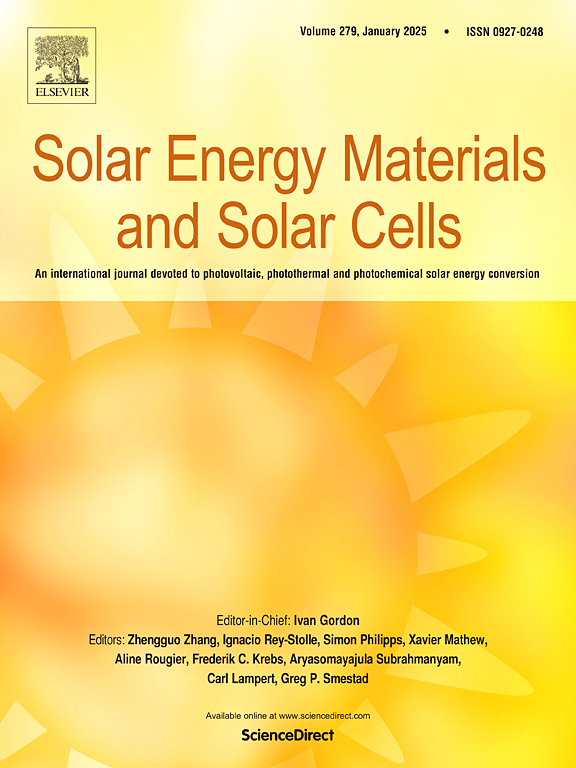Review of intrinsic vs. extrinsic recombination in germanium thermophotovoltaic converters
IF 6.3
2区 材料科学
Q2 ENERGY & FUELS
引用次数: 0
Abstract
Germanium thermophotovoltaic converters (TPV) can be a cost-effective alternative for the introduction of thermal batteries in the electricity storage market. However, at the high irradiances associated with this application and for indirect band-gap semiconductors such as Ge, the impact of Auger recombination is usually presented as an unavoidable efficiency limiting factor. In this work, we challenge this idea by revisiting the relative weight of the different intrinsic and extrinsic recombination mechanisms in Ge. To this end we summarize the literature about reported lifetimes in Ge and analyze the impact of radiative, Auger, and Shockley-Read-Hall (SRH) recombination on them. SILVACO TCAD is used to simulate the contribution of each recombination mechanism (including surface recombination) on the dark saturation currents of three Ge-based TPV converters manufactured on substrates with different dopant concentrations (NB = 3 × 1017 cm−3, NB = 1 × 1016 cm−3, NB = 1 × 1015 cm−3) under high irradiance conditions (JSC∼5 A/cm2). This analysis shows that the role of recombination in the bulk of the semiconductor is limited in current Ge, even for devices with substrate dopant concentrations NB = 3 × 1017 cm−3. This data is also used to estimate the impact of each recombination mechanism on experimental J-V curves previously reported for Ge-based TPV converters. This second analysis confirms that the cell performance barely increases after improving SRH bulk lifetimes. Instead, the impact of surface recombination is still critical, especially in medium-doped and lightly-doped devices, where an outstanding increase in open circuit voltage (VOC) and fill factor (FF) are observed, leading to potential TPV efficiencies over 30 %.

锗热光伏转换器内禀复合与外禀复合研究进展
锗热光伏转换器(TPV)可以成为在电力存储市场引入热电池的一种具有成本效益的替代方案。然而,在与此应用相关的高辐照度和间接带隙半导体(如Ge)中,俄歇复合的影响通常是不可避免的效率限制因素。在这项工作中,我们通过重新审视Ge中不同的内在和外在重组机制的相对权重来挑战这一观点。为此,我们总结了有关锗寿命的文献报道,并分析了辐射、俄歇和Shockley-Read-Hall (SRH)复合对锗寿命的影响。使用SILVACO TCAD模拟了在高辐照条件(JSC ~ 5 A/cm2)下,不同掺杂浓度(NB = 3 × 1017 cm - 3, NB = 1 × 1016 cm - 3, NB = 1 × 1015 cm - 3)的基片上制造的三种ge基TPV转换器的每种重组机制(包括表面重组)对暗饱和电流的贡献。该分析表明,即使对于衬底掺杂浓度为NB = 3 × 1017 cm−3的器件,复合在半导体主体中的作用在电流Ge下也是有限的。该数据还用于估计每种重组机制对先前报道的基于ge的TPV转换器的实验J-V曲线的影响。第二个分析证实,在提高SRH体积寿命后,电池性能几乎没有增加。相反,表面复合的影响仍然是至关重要的,特别是在中掺杂和轻掺杂的器件中,开路电压(VOC)和填充因子(FF)显著增加,导致潜在的TPV效率超过30%。
本文章由计算机程序翻译,如有差异,请以英文原文为准。
求助全文
约1分钟内获得全文
求助全文
来源期刊

Solar Energy Materials and Solar Cells
工程技术-材料科学:综合
CiteScore
12.60
自引率
11.60%
发文量
513
审稿时长
47 days
期刊介绍:
Solar Energy Materials & Solar Cells is intended as a vehicle for the dissemination of research results on materials science and technology related to photovoltaic, photothermal and photoelectrochemical solar energy conversion. Materials science is taken in the broadest possible sense and encompasses physics, chemistry, optics, materials fabrication and analysis for all types of materials.
 求助内容:
求助内容: 应助结果提醒方式:
应助结果提醒方式:


